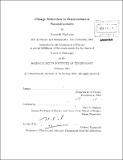Charge detection in semiconductor nanostructures
Author(s)
MacLean, Kenneth (Kenneth MacLean, III)
DownloadFull printable version (15.22Mb)
Other Contributors
Massachusetts Institute of Technology. Dept. of Physics.
Advisor
Marc A. Kastner.
Terms of use
Metadata
Show full item recordAbstract
In this thesis nanometer scale charge sensors are used to study charge transport in two solid state systems: Lateral GaAs quantum dots and hydrogenated amorphous silicon (a-Si:H). In both of these experiments we use time-resolved charge sensing to study electron transport in regimes that are not accessible to traditional transport measurements. For the lateral GaAs quantum dot experiments, we use a GaAs quantum point contact integrated with the dot as a charge sensor. We use this sensor to observe single electrons hopping on and off the dot in real time. By measuring the time intervals for which the dot contains one and zero electrons, we probe the rate F at which electrons tunnel on and off the dot from the leads. We measure F as a function of the drain source bias V, and gate voltages V applied to the dot. At zero magnetic field, we show that the dependencies of F on Vda and V can be understood in terms of a simple quantum mechanical model which takes into account variations in the electron energy relative to the top of the tunnel barriers separating the dot from the leads. We also show that the tunneling is dominated by elastic processes. At high magnetic fields, we show that tunneling into the excited spin state of the dot can be completely suppressed relative to tunneling into the ground spin state. The extent of the suppression depends on the shape of the electrostatic potential defining the quantum dot. For the a-Si:H experiments, we pattern a nanometer scale strip of a-Si:H adjacent to a narrow silicon MOSFET (metal-oxide-semiconductor field-effect transistor), which serves as an integrated charge sensor. We show that the MOSFET can be used to detect charging of the a-Si:H strip. By performing time-resolved measurements of this charging, we are able to measure extremely high resistances (~ 1017 Q) for the a-Si:H strip at T ~ 100 K. At higher temperatures, where the resistance of the a-Si:H strip is not too large, we show that the resistances obtained from our charge detection method agree with those obtained by measuring current. Our device geometry allows us to probe a variety of electron transport phenomena for the a-Si:H, including the field effect and dispersive transport, using charge detection. We extract the density of localized states at the Fermi level for the a-Si:H and obtain consistent results. We discuss the effect of screening by the substrate on the sensitivity of the MOSFET to charge in the a-Si:H, and show that the MOSFET can detect switching noise in the a-Si:H.
Description
Thesis (Ph. D.)--Massachusetts Institute of Technology, Dept. of Physics, 2010. Cataloged from PDF version of thesis. Includes bibliographical references (p. 137-145).
Date issued
2010Department
Massachusetts Institute of Technology. Department of PhysicsPublisher
Massachusetts Institute of Technology
Keywords
Physics.